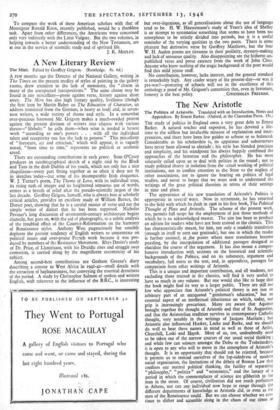A New Literary Review
The Mint. Edited by Geoffrey Grigson. (Routledge. 8s. 6d.) A FEW months ago the Director of the National Gallery, writing in The Times on the present medley of styles of painting in the gallery rooms, drew attention to the lack of monotony, the " charm in many of the unexpected juxtapositions." The same charm may be found in any miscellany—prose against verse, history against short story. The Mint has also high literary quality, liveliness (though the first item by Martin Buber on The Education of Character, an address translated from the German, is heavy as lead) and, in seven- teen writers, a wide variety of theme -and style. • In a somewhat over-precious foreword Mr. Grigson makes a much-needed protest against the present division of writers into cliques with various theses—" lifebelts " he calls them—when what is needed is honest work " according to one's powers . . . with all the individual talent and receptivity one has the luck to possess." This miscellany of " literature, art and criticism," which will appear, it is vaguely stated, " from time to time," represents no political or aesthetic creed.
There are outstanding contributions in each genre. Sean O'Casey produces an autobiographical sketch of a night raid by the Black and Tans in the drab Dublin of his youth, which not only has a nice shapeliness—every part fitting together as so often it does not fit in sketches 'today—but some of his incomparable Irish eloquence. W. J. Turner's poem, The Theme of Love, with its individual tone, its rising rush .of images and its heightened sensuous use of words, comes as a breath of relief after the pseudo-scientific jargon of the last decade. Geoffrey Grigsol. himself, who is always best at scholarly critical articles, provides an excellent study of William Barnes, the Dorset poet, showing that he is a careful mister of verse and not the simple writer of dialect that he has been supposed. Nicholas Pevsner's long discussion of seventeenth-century architecture begins clumsily, but goes on, Oiith the aid of photographs, to a subtle analysis of the troubled effect of the Counter-Reformation on the harmony of Renaissance styles. Anthony West pugnaciously but sensibly deplores the present tendency of English writers to concentrate on political issues and over-praise French work because it was pro- duced by members of the Resistance Movement. Rhys Davies's study of Dr. Price, of Llantrisant, with his Druidic rites and struggle over cremation, is carried along by the magnificent eccentricity of his subject.
Among second-best contributions are Graham Greene's diary describing a convoy to West Africa in 1941-42—small details with the attraction of haphazardness, but conveying the essential dreariness of the period. A study by Christopher Salmon of spoken and written English; with reference to the influence of the B.B.C., is interesting
but over-ingenious, as all generalisations about the use of language tend to be. H. W. Hansermann's study of Yeats's idea of Shelley is an attempt to systematise something that seems to have been too amorphous to be strictly divided into periods, but it is a useful reminder of the varying qualities in the two poets. There is some pleasant but derivative verse by Geoffrey Matthews, but the four W. H. Auden poems are tiresome in their prolixity, mystery-making and lack of sensuous quality. Also disappointing are the hitherto un- published verse and prose extracts from the work of John Clare. Anyone who knew nothing of the tragic background of the poet would find this mild jejune sniff. No contribution, however, lacks interest, and the general standard is remarkably high. Any reader weary of the present-day—or was it pre-war?—posturing of schools will see in the excellence of this anthologya proof of Mr. Grigson's contention that, even in literature,


























 Previous page
Previous page